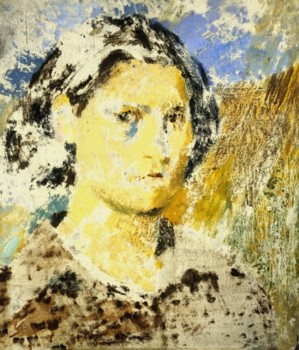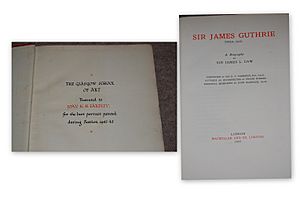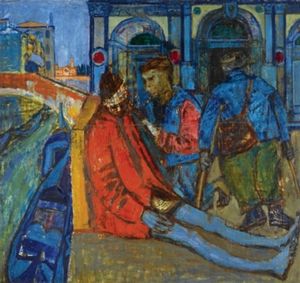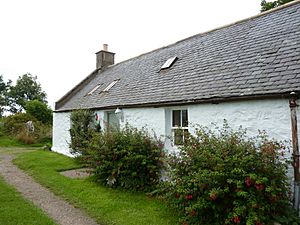Joan Eardley facts for kids
Quick facts for kids
Joan Eardley
|
|
|---|---|

Self-portrait, 1943
|
|
| Born |
Joan Kathleen Harding Eardley
18 May 1921 Warnham, West Sussex, England.
|
| Died | 16 August 1963 (aged 42) Killearn Hospital
|
| Education | Glasgow School of Art |
| Awards | Sir James Guthrie Prize |
| Elected | Royal Scottish Academy (1963) |
Joan Kathleen Harding Eardley (born May 18, 1921 – died August 16, 1963) was a famous British artist. She was well-known for her paintings of children in the streets of Glasgow. She also painted beautiful landscapes of Catterline, a fishing village on the North-East coast of Scotland.
Contents
About Joan Eardley
Her Early Life
Joan Eardley was born on a farm in Warnham, England. Her parents were dairy farmers. Her mother, Irene, was Scottish. Her father, William, was a soldier who fought in World War One. He became ill after the war.
In 1926, Joan's family sold their farm. Her mother took Joan and her younger sister, Pat, to live with their grandmother in Blackheath, London. In 1929, an aunt helped pay for Joan and Pat to go to a private school. This was St Helen's School, where Joan's talent for art was first noticed.
Joan studied art at a local school in Blackheath. In 1938, she went to Goldsmiths College for a short time. In 1939, Joan, her mother, and sister moved to Glasgow, Scotland. They lived with relatives in Bearsden.
Art School in Glasgow (1940–1948)
In 1940, Joan started studying at the Glasgow School of Art. She learned from Hugh Adam Crawford. She was also inspired by the Scottish Colourists, a group of artists. The work of Polish artist Josef Herman also influenced her.
She met painter Margot Sandeman, who became a lifelong friend. Joan and Margot often painted together. They also went on family holidays and camping trips. In 1941, they bought a horse and caravan. They traveled around Loch Lomond to paint and sketch. For many years, they visited Corrie, Arran on the Isle of Arran. They used an old outhouse as their art studio.
By 1942, Joan finished the General Course at art school. She then started a special course in drawing and painting. The next year, she earned her diploma. Her self-portrait painting earned her the Sir James Guthrie Prize. Her teacher, Hugh Adam Crawford, bought the painting. This painting showed her informal style, which she later used to draw Glasgow street children.
After graduating in 1943, Joan trained to be a teacher. However, she did not enjoy teaching in classrooms. She left after one term. Instead, she worked as a joiner's apprentice. She helped a small boat building company in Bearsden. In 1944, she painted camouflage patterns on landing craft for the war. This work allowed her to attend evening classes at the Glasgow School of Art until 1946.
During the war, her painting The Mixer Men was shown at the Royal Glasgow Institute of the Fine Arts. Around 1945, Joan made some prints using a wood engraving method. She did not continue with this technique. In 1947, she worked on a mural for a school in Lincoln, England. She then returned to Scotland to study at Hospitalfield House in Arbroath. Her teacher, James Cowie, inspired her to paint everyday subjects. In 1948, Joan went back to the Glasgow School of Art for a special post-diploma course.
Her Trip to Italy (1949)
In 1948, the Royal Scottish Academy gave Joan a scholarship. This allowed her to visit Italy and Paris for several months in 1948 and 1949. In September 1948, she traveled to Florence, Italy. There, she saw many artworks by Italian Renaissance artists. She especially liked the fresco paintings by Giotto and Masaccio. She admired how these artists showed humanity and strong shapes in their work.
She visited churches in Assisi. Then she went to Forte dei Marmi in November 1948. She painted fishermen working on their nets. This was a subject she would paint again later in Catterline. Joan spent Christmas 1948 in Paris. In January 1949, she traveled to Venice. She became ill in Venice and had to go back to Florence for treatment.
Once she felt better, she spent time in Arezzo, Ravenna, Florence, and Venice. At the start of her trip, Joan destroyed most of her paintings. But in Venice, she painted and kept several works. During her time in Venice in 1949, Joan mainly used charcoal and pastels. Beggars in Venice is one of the few oil paintings she made then. The strong blue color shows her love for Giotto's art. The painting shows a large square in Venice. Joan painted the beggars there with kindness. She later showed the same kindness when painting people in Glasgow.
When she returned to Scotland in 1949, she had her first solo art show. It featured her work from Italy, including scenes of peasants, beggars, children, and old women. The show was at the Mackintosh Gallery of the Glasgow School of Art. It received much praise. Several of her works were bought by the Aberdeen Art Gallery and the Glasgow School of Art.
Painting Glasgow Life (1950–1957)
In 1949, Joan set up an art studio in Townhead, a poor and crowded area of Glasgow. This area was planned to be torn down. Her first studio was on the fourth floor of a tenement building. Later, she moved to a space above a scrap metal store. She was sad to leave her first studio because it was easy to get the children to come up and pose.
In Townhead, Joan drew and painted the poorest city children. They often played in the streets in torn clothes. Older girls looked after their younger brothers and sisters. Joan captured the energy and sometimes awkwardness of these children. The twelve children of the Samson family were often her subjects. Joan also made chalk drawings on scraps of paper or sandpaper. These drawings became the basis for her oil paintings of groups of children.
Her paintings from this time show a strong sense of community. Examples include Street Kids, Glasgow Kids, A Saturday Matinee Picture Queue, and Children, Port Glasgow. These paintings use thick layers of paint. Joan said she wanted to show how the children "let out their life and energy." She loved the "richness that Glasgow has." In some paintings, Joan used collage. She added scraps of newspapers and sweet wrappers. She also included graffiti and shop signs from abandoned stores.
After moving studios, Joan started using photographs to help her paint. She took her own photos. Photographer Audrey Walker also worked with her and provided pictures. Audrey also photographed Joan while she worked. Documentary photographer Oscar Marzaroli admired her art. He took pictures of the Samson family in her studio. Joan also drew many scenes of the shipyards in Port Glasgow. She developed a unique style. She became known as a realistic and kind artist of city life. People often saw her pushing her easel and paints around Glasgow in an old pram.
Life in Catterline (1957–1963)
In 1950, Joan was recovering from an illness. A friend, Annette Soper, took her to visit Catterline. This was a fishing village near Stonehaven, south of Aberdeen. Joan had an art exhibition there at the time. Joan began to spend part of each year in Catterline. By 1961, the small village became her permanent home.
At first, Joan worked from Watch House, an old Coast-guard building. Her friend Annette owned it and let Joan use it freely. In 1955, Joan bought a cottage called Number 1, The Row. It was on the cliff edge. She used it as her home and studio. In 1955, she bought Number 18, The Row, and kept Number 1 for storing her paintings. Number 18 was better for living in, but it was still a very simple cottage. It had no electricity, running water, or indoor toilet. She called it "a great wee house." She said, "I am sitting looking out at the darkness and the sea. I think I shall paint here. This is a strange place – it always excited me."
In her first years in Catterline, Joan painted the fields and cottages around the village. She started painting beach and sea scenes later. For both her sea and landscapes, Joan created series of works. She often showed the same view in different light and weather. She even painted during storms. She painted landscapes showing the changing seasons. Her thick paintwork sometimes included real pieces of plants. For Summer Fields (around 1961), she added grass to the paint. Harvest (1960–61) includes bits of grit. She usually worked outdoors, even in bad weather like snowstorms or strong winds.
The Wave from February 1961 was painted entirely outdoors. It was one of four paintings she made during a particular storm. The tides decided which painting she worked on at any time. When she heard a storm was coming, Joan would travel from Glasgow to Stonehaven. Then she would ride her Lambretta scooter to Catterline. For her sea paintings, Joan started using large boards instead of canvas. This gave her a stronger surface to work on. Some boards were as large as six feet long.
Joan once said about Catterline: "When I'm painting in the North East, I hardly ever move out of the village. I hardly ever move from one spot. I do feel the more you know something, the more you can get out of it. That is the North East. It's just vast waves, vast areas of cliff. Well you've just got to paint it."
In 1955, Joan became an associate member of the Royal Scottish Academy. In 1963, she became a full member. The same year, an exhibition of her work was held in London. However, she was too ill to attend.
Her Death
In 1963, Joan was diagnosed with breast cancer. It had spread to her brain. Friends cared for Joan in Catterline during her last months. She died at Killearn Hospital in August 1963. She was 42 years old. Her mother, sister, and Audrey Walker were with her. A large painting of the Samson sisters, Two Children, was left unfinished in her studio. She had kept working until she lost her eyesight. Her ashes were scattered on Catterline beach.
Her Legacy as an Artist
Many people in Britain highly praised Joan Eardley's work by the time she died. She created over 300 paintings and 1400 sketches. These are now in art galleries or private collections. After her death, she was recognized as an important artist around the world.
A special exhibition of her work was held in Edinburgh in 1988. The Scottish National Gallery of Modern Art has many of her paintings. So do the Glasgow Museums. They have coastal landscapes like Catterline Coastal Cottages (around 1952) and paintings of people like Two Children from 1963.
Dr. Janet McKenzie of the National Galleries of Scotland said that Joan's early death meant she did not get the fame she deserved. Guy Peploe said, "There was a desperate urgency to her work. It was almost as if she knew that she was not going to be the grand lady of Scottish art." Murdo Macdonald said that Joan understood the sea better than almost any other painter. She painted waves as heavy, fast-moving water.
One of her biographers, Cordelia Oliver, said that for Joan, a truly successful painting had to go deeper than just looking accurate. She said Joan was able to combine a sharp artist's eye with warm human kindness and understanding.
Memberships and Awards
Joan Eardley was part of these art groups:
- 1948: Professional member of the Society of Scottish Artists
- 1955: Elected Associate of the Royal Scottish Academy
- 1963: Elected full member of the Royal Scottish Academy
- 1963: Honorary member of Glasgow Society of Lady Artists' Club
Exhibitions of Her Work
Here are some exhibitions of Joan's work held during her life:
- 1948: An Exhibition of Paintings and Drawings of Italy made by a Travelling Scholar at the School, Joan Eardley, Glasgow
- 1950: Solo exhibition, Gaumont Gallery, Aberdeen
- 1959: Solo exhibition, 57 Gallery, Edinburgh
- 1961: Solo exhibition, the Scottish Gallery, Edinburgh
- 1963: Solo exhibition, Roland, Browse & Delbranco Gallery, London
Exhibitions After Her Death
- 1964: Joan Eardley Memorial Exhibition, Kelvingrove Art Gallery and Museum and at the Royal Scottish Academy, Edinburgh.
- 2007: Retrospective, National Galleries of Scotland, Edinburgh
- 2007: Retrospective, the Scottish Gallery, Edinburgh
- 2008: Retrospective, the Fleming Gallery, London
- 2014: Refiguring the 50s, group exhibition, Ben Uri Gallery, London
- 2015: Joan Eardley: Time and Tide, Clydebank Museum and Art Gallery
- 2017: Joan Eardley: A Sense of Place, Scottish National Gallery of Modern Art, Edinburgh
- 2021: A series of exhibitions and events to celebrate 100 years since her birth.




